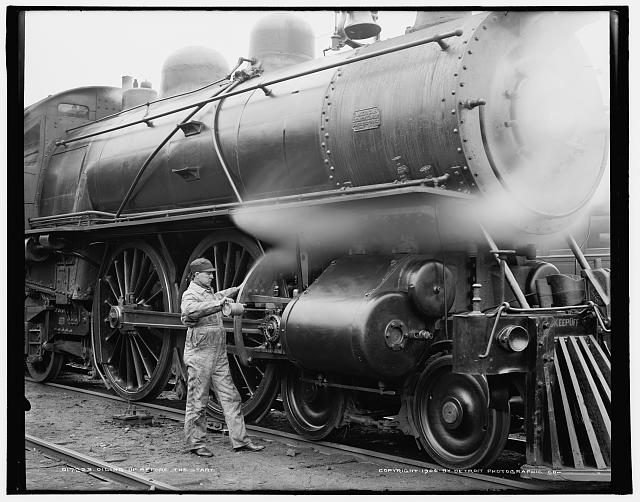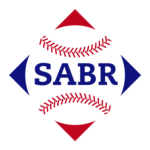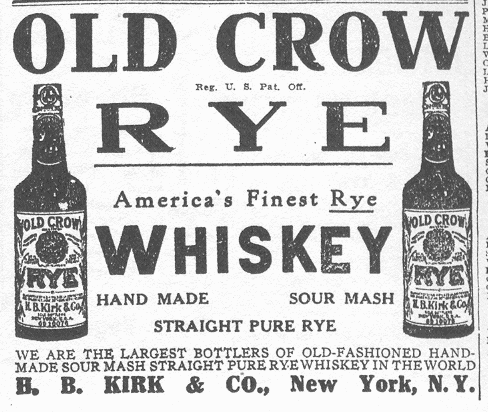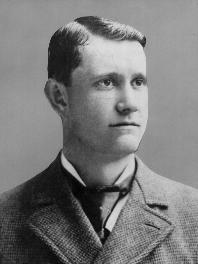It was one hour to the end of July 2, 1903 as Michigan Central No. 6 rattled across the International Bridge and the darkness of the Niagara River below. He traveled alone, leaving his teammates what turned out to be a half day behind.
Back then, the shortest trip from Detroit back east was through Canada, hence the train trip that took him within ten miles of Niagara Falls. Though the train would be arriving in Buffalo within fifteen minutes, it would mark roughly only the halfway point of his journey as he’d be arriving in a bustling Grand Central Terminal late the next morning. He was fortunate as the remainder of his trip would take him approximately ten hours as scheduled train service from Buffalo to New York took as long as fifteen, cost being the major factor.

(Detroit Publishing Co. through the Library of Congress)
He had been acting erratically in recent weeks, paying more visits to the alcohol that he never quite swore off of ten years ago. Lots of folks in his line of work drank. Without a lot of entertainment and other distractions after an afternoon game, especially on the road, it was convenient to “belly up” to the hotel bar and discuss the day’s game, or any other subject that came to mind. Sometimes–many times–he just drank alone. Besides, while he knew the alcohol took control of him, he was somewhat comforted that he wasn’t like some of the old timers. Charley Radbourn reportedly drank a quart of whiskey every day back in the eighties. Of course, pitching a couple six hundred inning seasons back to back would make nearly everyone reach for some of that liquid pain killer.
That which drove him to drink was out of his control. Though many people worked hard to keep up their skills and earn a major league paycheck, his work came easy to him and was among the best in the game for the past dozen years. When many players his age were either heading downhill or gone altogether, he was still pounding the ball and looked to have another four or five very productive years left in him.
It was a cadre of rich men toying with his livelihood and others, bargaining and trading them as if they were cattle, which frustrated him and made him crawl into the shell of a whiskey bottle, sometimes for days at a stretch.
Though some of his professional life was a blur, dulled by stuff that came out of bottles with names such as Calvert, Sherwood and Old Crow on them, he was more focused now than at even the most lucid times he could remember. Proof that he wanted to “turn the corner,” so to speak, was his handwritten pledge he signed in front of a Catholic priest only three days before promising to “clean himself up.” Even the promise of a long, stuffy train ride didn’t dull his senses.
– Excerpt from “Big Ed” by Mark Ruckhaus
Editor’s Note: Baseball is a game filled with “What If’s”. Baseball simulation games give us a glimpse of what might have happened if certain things in history had changed. Washington Senators slugger Ed Delahanty passed away in 1903 at the age of 35 when late at night, he fell from the International Railway Bridge in Buffalo, New York, into the Niagra Falls. He had dominated 1890s baseball as he hit over .400 at least three times, led the league in slugging percentage four times, RBIs three times, and stolen bases once. He was also a gifted, athletic center fielder.
Mark Ruckhaus wrote an alternative history from the perspective of Delahanty had he lived to finish out his career. Written over multiple years by Ruckhaus, “Big Ed” contains over 600 pages and is posted in its entirety within the Delphi forums here. The first post is excerpted above. Included below is a Q&A with Ruckhaus conducted by SABR Games and Simulations Committee co-chair Joe Runde.
You can read more about Ed Delahanty courtesy of John Saccoman at the SABR Bio Project.
Questions from Joe Runde for Mark Ruckhaus on Big Ed
Runde: You used a computer simulation to project what might have happened if Ed Delahanty had not tumbled over the falls. Which simulation? How did you project his performance going forward from July 2, 1903?
Ruckhaus: I used APBA Baseball for Windows but with the Skeetersoft seasons, the reason being that Bill Staffa has a far better feel for Deadball than does APBA, though I like the BBW program and enjoy how it plays. For projecting Delahanty to 1908, I used Bill James’ Brock projection. Forgot which version, as it’s been updated over the years. But that’s what I used and created versions of Delahanty from 1904-08.
Runde: What led you to fill out your projection with narrative?
Ruckhaus: It was a combination of a couple things, I guess. There was a fellow over on the Diamond Mind board–he goes by the screen name of Frank108–who ran a fictional draft league that started in 1927. I think he’s up to somewhere around 1980 by now. Anyway, it was called “Snapshots from Boothby Marsh.” Though it was more vignettes than anything (hence the team “snapshots”), I found his writing to be brilliant and it gave me the impetus to give “Big Ed” a go. The other was that I don’t recall anyone writing a baseball alternative history tome. There’s plenty of alternative history out there, but nothing in baseball. Well after I started writing, Harry Turtledove, who’s a very gifted alternative history writer, wrote a Babe Ruth short story–the version where he never made it, he’s now in his mid-40s and was tending bar in what was once his father’s saloon in Baltimore. There’s some great baseball fiction, such as “If I Never Get Back” and “The Celebrant.” And darned near anything by Ring Lardner. But no alternative history. And rather than merely running a replay and doing game write-ups along with my sometimes snarky and sarcastic comments, which I’m doing now with SKS’ Dynasties set, I wanted to see if I could make something more of it.
Runde: Did the simulation drive the development of your narrative? (Had the results been different, would that have changed your storyline?)
Ruckhaus: Absolutely. As I said–probably more than once in that 600+ pages, sometimes this stuff wrote itself. The Browns’ 2B (forgot who) pushing Hal Chase (I had him ending up there and, as the story ended in 1908, whatever became of him is open to conjecture) out of the way to catch a game-ending pop fly because a few players on the Browns thought Chase was already involved in some skullduggery and thought he might drop it. The play by play said the 2B reached over Chase to make the play. And now I have myself a story. I went strictly by the results given by the sim and didn’t fudge anything to fit the story. Any trades and including black players came from my fertile mind and stuff like injuries was given to me by the game and an injury system I conjured up. And, if a player was supposed to miss a month, he missed a month. Didn’t matter if it was Wagner or a bench jockey. So, had the storyline shown Delahanty running into a wall in 1907 and missing half the season, it’s likely that the story would have ended there and I would have had to come up with an alternate ending. Fortunately, that didn’t happen.
Runde: Do you see yourself shaping this narrative into a novel, an alternative history? For publication?
Ruckhaus: It kind of already is. I just never knew what to do with it as it’s been gathering dust in my computer for five years or more. It’s lengthy. If an editor wants to tackle it, fine. I guess my thought is that everyone should write at least one book in their lifetime. This is mine.
Runde: Your handling of the inter-league raiding and contract disputes is highly detailed. That information did not come from your sim. What are your sources and how did they shape your projection?
Ruckhaus: I knew what had happened in real life, including that the NL almost became a trust. And I knew that syndicate baseball was still alive (actually I learned that as I was doing some research as I thought that had died with the 1900 contraction) and that the NL owners were a fractured bunch. Obviously, no sim can write a story like that, so I tried to find a possibility where some of the NL owners would team up with Ban Johnson. So, that came out of my own mind. Whether others more steeped in baseball history and the machinations of that area think my thought process is ridiculous is up to them. I think it’s plausible. Maybe there was a more obvious way to move this story; I don’t know.
Runde: You bring Rube Foster and other African-Americans into the major leagues within two decades of the ‘gentleman’s agreement.’ How do you see this action relating to Delehanty coming to the Giants? Is there any evidence that some baseball men wanted to breach that ‘agreement’ in this timeframe?
Ruckhaus: McGraw wanted to sign a black player (Charlie Grant) and was rebuffed. So, I saw him signing Foster in the waning days of the NL in 1903 as his thumbing his nose at them. And, deep down, I don’t think the owners were racists. Matter of fact, I think they saw more money in a separate black league and they (the owners) saw more money in renting out their parks than in integrating their teams. So, my version brought baseball race relations of the late 1940s (a handful of blacks) to 1903-04. As owners and managers are generally copycats as they seem to use the same business model and strategies with occasional pioneers sometimes showing a new way–not necessarily good, but new (Stallings with platooning, Billy Beane with “Moneyball” and LaRussa with micromanaging, and, of course, Branch Rickey with Jackie Robinson, to name four), once McGraw had success with Foster, others followed with a relative trickle of black players coming into the new AL. Is it plausible? Who knows? I think it is or could have been. That’s my story and I’m sticking to it. 🙂
Runde: Have you used your projected ratings a second time? A third? To see alternative results and story lines you might generate?
Ruckhaus: No. Honestly, I never gave it a thought as I was happy with the first version. Plus, going back to square one and going through the permutations in a story that took three or four years to write the first time…no, thanks.
Mark Ruckhaus has spent over thirty years on the technical side of the television business including stints with the NFL and the ’92 Winter Olympics. He has been a horse racing track announcer for Goshen and Monticello and worked for the Newark Bears. He edited “Inside The Game”, the Deadball newsletter for the Society for American Baseball Research and is currently editing the SABR Oral History Committee’s Newsletter.
- Joseph Rundehttps://sabrbaseballgaming.com/author/joer/
- Joseph Rundehttps://sabrbaseballgaming.com/author/joer/
- Joseph Rundehttps://sabrbaseballgaming.com/author/joer/
- Joseph Rundehttps://sabrbaseballgaming.com/author/joer/



